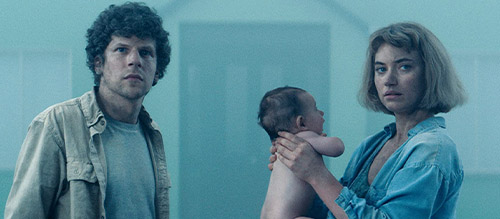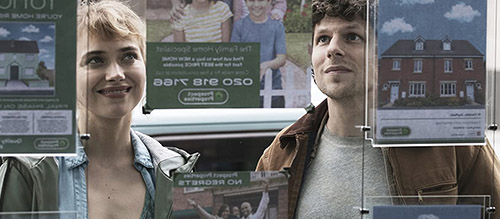Breaking Principles: Passive Characters in ‘Vivarium’ (2020)
I had the pleasure of watching Vivarium at Abertoir Festival 2019, and, safe to say, it was very divisive. Some criticised it for being slow and not presenting firm answers, while others (including myself), praised it for exactly those same reasons. Now that it’s had its online release, I’d like to pick up on the thing that I most loved about it.
For obvious reasons, SPOILER WARNING, because I’ll be discussing the film in depth. Go find it and watch it first, or just don’t care and read on; who am I to judge?
The topic of discussion today is to be specifically that of the nature of the film working deliberately to frustrate the viewer by focusing on actively-passive characters against all traditional writing conventions.
Many reviewers have discussed the film in relation to the horrors of suburbia, the closed feeling of modernity, of the sterilisation of individuality, etc., and these all come into play to give the film a chilling, clinical feel to it, of this there is no doubt – the scenario alone is indeed calmly disturbing.
However, many films in the same scenario would not achieve the same results if written by others, because their characters would be what we call ‘active’ characters.
An active character is one that goes after what they want; they drive the action on. This is James Bond jet -setting across the globe to fight his way through hoards of goons and stop the bomb exploding. It’s every guy in every rom-com going through an elaborate plan to win over the girl. These are characters that physically push on the narrative with each action they take. ‘Passive’ characters, on the other hand, are characters that let the narrative happen to them. A good example would be the opening escape of Captain Jack Sparrow in Pirates of The Caribbean: Salazar’s Revenge. The action happens around him, and although we follow him bumble his way through to the end, everything conveniently happens to fall his way. He doesn’t construct an escape route; one appears for him.
The theory and guiding principal of screenwriting (and fiction in general) is that you should always make your main character(s) active, with an overarching goal for the story and needs to accomplish in each scene. In every conversation in every scene, a main character should always be getting closer to the end result through active means. It’s not always the case, but it’s a good rule of thumb to use if in doubt.
Imagine if Sherlock Holmes didn’t actually do any detecting, but all the clues came his way by coincidence, spelled out for him, and right at the very end he simply ties everything together in a neat package and presents it. It would be boring, and the viewer would feel that they’ve been cheated. Instead, thankfully, Holmes is always on the move, examining this, looking there, putting clues together, and chasing after the villain. He is a thoroughly active protagonist. Indeed, some of the funniest moments appear in the various stories and adaptations when he’s lounging around and bored. Remember Cumberbatch shooting the wall in the BBC adaptation ‘Sherlock’ out of sheer boredom? That’s the audience when your character is passive.
To turn back to Vivarium…
Trapped in an endless suburbia with an all-seeing eye preventing their escape, Tom and Gemma (Jesse Eisenberg and Imogen Poots) are constantly looking for a way out. They walk for miles, drive endlessly, paint ‘help’ onto the roof. It eventually descends into them trying to force the answer out of their ‘child’. Tom takes to digging a massive hole in the garden, endlessly trying to tunnel out. And yet, each attempt is stopped. When we think we’re getting closer to an answer, the film shuts us down.
Time after time we cut back to them reluctantly accepting the monotony of their imposed lives; brushing their teeth, eating breakfast, etc. – they’re constantly in a ‘passive’ state. They give up trying to drive out. They give up expecting anyone to come and rescue them. Whenever a possible chink in the armour of their oppressors appears they go after it, only for the gap to close up like a healing wound, the fatal blow yet to be inflicted. At every step of the way, they are prevented from driving the scenario forward. They must simply put up with each other, alone.
On one hand, this is incredibly frustrating. The nearest we get to answers is a surreal, sliding-through-reality sequence near the end that presents images, but gives no facts. All it proves is that there is something out of the ordinary, all around us, which we already knew. It tricks us by presenting old information as new. We think we’ve made a step forward, but we haven’t. In the film’s final moments, when the non-adventure ends with Martin going to the estate agents to welcome in another couple, the cycle begins again. Just like the characters’ days, the main story elements are doomed to be repeated over and over again.
And, at the end of all this, what have we learned about what’s really occurring? Nothing about why it is happening or what goes on behind the scenes, nor anything about how it’s all managed. Is it some sort of government facility? Is it aliens? A hallucination? A slip in time? A television show? How is the food manufactured? Why does nobody stumble into it by accident? What prevents them from escaping? How could the whole setup have appeared without anyone noticing? What are the instructions that Martin receives? What happens in the outside world when the characters are gone? All of these questions, and more, are never answered, and in a way, that’s precisely the point.
The exact narrative scenario is irrelevant. The film is about the disillusionment of perceived ‘perfection’, of the advertised ideal. It is a film about realising passivity. Personally, I see it as a disguised metaphor for societal standards of aspirational normality. Acquiring a clean, suburban house with a partner and child is the ideal position for the population; where we are meant to be in life. In this sense, trying to achieve more, personal aspirations or individuality, going against the norm, is actively frowned upon as it implies that the clinical setup isn’t everything anyone could ever wish for. Because of this, the unseen forces which make up modern society (government, advertising, mass-entertainment, religion, social groups, etc,) actively push back against this in order to maintain the grand narrative. In this way, frustrating our normal expectations of a narrative which opens up, which expands through the exploits and ventures of an active protagonist, deliberately highlights these very concepts of being pushed back in line.
A final added bonus of all of this, is that it means we have two actors who have nothing better to do than simply act. They, and the audience, are forced to share in their every moment, because there is nothing else to do. We relish in their joy of dancing in a car’s headlights. We feel it when they fall out and grow bored with one another. There are no terrorist plots or vampires or armies of darkness to foil our appreciation of character here. We just get to watch two people love and live and feel, with almost no distractions, and it is absolutely wonderful. Vivarium, by breaking the principles of active and passive characters, turns this to its advantage. The final result is simply breathtaking.
Article by Kieran Judge
Twitter: @KJudgeMental



